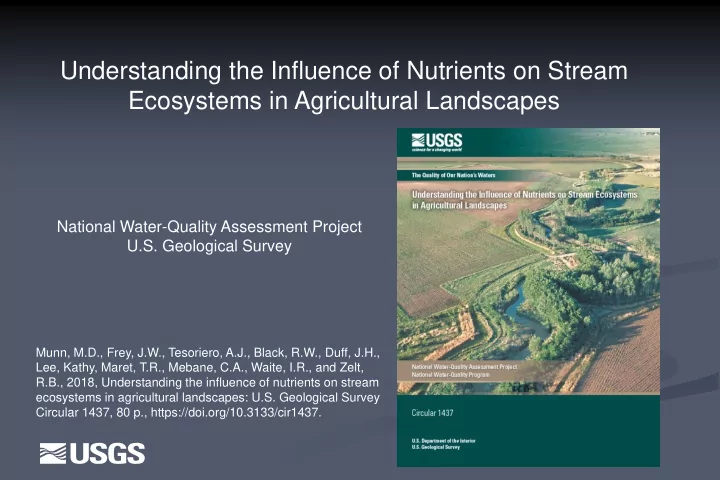

Understanding the Influence of Nutrients on Stream Ecosystems in Agricultural Landscapes National Water-Quality Assessment Project U.S. Geological Survey Munn, M.D., Frey, J.W., Tesoriero, A.J., Black, R.W., Duff, J.H., Lee, Kathy, Maret, T.R., Mebane, C.A., Waite, I.R., and Zelt, R.B., 2018, Understanding the influence of nutrients on stream ecosystems in agricultural landscapes: U.S. Geological Survey Circular 1437, 80 p., https://doi.org/10.3133/cir1437.
Objectives Assess response of biological communities to nutrients. 1. n=232, algae and invertebrates, nutrients, habitat, GIS Assess influence of nutrients on aquatic vegetation. 2. n=232, macrophyte cover and algal biomass n=40, primary productivity Assess nutrient processes in agricultural streams. 3. n=7, uptake and loss
Study Design Study areas selected Agriculturally dominated study areas 1. Estimates of nitrogen and phosphorus input into study areas 2. Sufficient number of independent streams 3. Sites selected (ca 30 per study area) Within study area Level 3 ecoregion 1. Sites spanned a range in nutrient conditions (watershed 2. loadings) Wadeable and “natural” 3.
Study Areas
Percent agricultural land use Percent of agriculture in basin
Majority of sites exceeded background nutrient concentrations
Algal and invertebrate communities were altered under increasing nutrient concentrations • Managers can consider strategies that take advantage of the wide variety of tools available to reduce nutrient inputs to streams. • Use multiple taxonomic groups (e.g., algae, invertebrates). Mean biological condition, in percent Biological condition compares the observed number of taxa at a sampling site to the number of taxa expected based on a set of regional reference sites, commonly referred to as the O/E score.
The most impaired biological conditions occurred in areas with the highest concentrations of nutrients Unaltered Altered
Stream habitat plays an important role in determining biological communities in agricultural streams • Incorporate habitat assessments in nutrient studies Percent of variability in invertebrate condition explained by habitat and nutrient variables (regression model)
Limiting the amount of agricultural land along stream buffers can improve algal and invertebrate community condition • Maintaining or improving riparian buffers is an important management tool. Algal community condition, in percent
Elevated nutrient concentrations do not always result in nuisance levels of aquatic vegetation in agricultural streams • Biological assessments are important for classifying streams locally; however, regardless of local response, high nutrients can affect downstream systems. Benthic chlorophyll a (mg/m 2 ) Total phosphorus (mg/L)
Benthic algal biomass: 13 percent exceeded 100 mg/m 2 benchmark Macrophytes: 10 percent exceeded 40 percent benchmark
Primary production in agricultural streams can range from low to high production Median primary productivity, in grams of dissolved oxygen per square meter per day
Loss of nitrogen in streams is diminished by agricultural practices that decrease the amount of time water is temporarily stored • Protect or restore the physical complexity of a stream which will benefit the local stream as well as downstream receiving waters impacted by nutrient loading. 20 15 10 5 0 0 100 200 20 15 10 5 0 Percent of travel time water is stored 0 100 200 in the stream
Advances in modeling improve our understanding of how invertebrate communities respond to interactions of land use, habitat, and nutrients • Incorporate interaction models to better understand the influence of indirect and direct factors. Eastern study areas: Forested wetlands key for reducing nutrient input to streams
Summary Algae and invertebrates both respond to increased nutrients, but algae provide a more direct response. Nutrient concentrations and benthic algal biomass do not always provide the best indication of stream status. Agricultural streams can be nutrient saturated and habitat limited. Reduced N loss in agricultural streams results in increased nutrient loads downstream. Predictive models that incorporate nutrients, habitat, and biological response can improve our understanding of interactions between them. http://wa.water.usgs.gov/neet/
Questions? mdmunn@usgs.gov, https://wa.water.usgs.gov/neet /
Recommend
More recommend